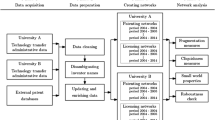Abstract
Despite strategic research has been done in recent years to study how network topology shapes the evolution of competition in various industries, previous researches do not investigate the importance of high betweenness point on the connectivity of patent citation networks. The goal of this report is to examine and characterize the small world phenomenon in the patent citations network by analyzing the data of RFID patents. The results suggest that the patent citation network can indeed be characterized as “small world”. Additionally, the patent citation network resembles the power-law connectivity distribution and exhibits preferential connectivity behavior. In other words, a few key patents have a great many more connections than the majority of patents with few connections. Furthermore, the patents of high betweenness centrality were identified. It is found that 81% of the patent citation activities have relations with the patents of high betweenness centrality. The result of this analysis will provide a specific way for managers to identify key patents, to map their own patent deployment and to derive insight into the best ways to navigate within such networks.





Similar content being viewed by others
References
Abraham, B. P., & Moitra, S. D. (2001). Innovation assessment through patent analysis. Technovation, 21(4), 245–252.
Almeida, P. (1996). Knowledge sourcing by foreign multinationals patent citation analysis in the US semiconductor industry. Strategic Management Journal, 17(Winter), 155–165.
Asif, A., & Mandviwalla, M. (2005). Integrating the supply chain with RFID: A technical and business analysis. Communications of the Association for Information Systems, 15(24), 393–427.
Barabási, A. L., & Albert, R. (1999). Emergence of scaling in random networks. Science, 286(5439), 509–512.
Barceló, J. M., Nieto-Hipólito, J. I., & García-Vidal, J. (2004). Study of internet autonomous system interconnectivity from BGP routing tables. Computer Networks—The International Journal of Computer and telecommunications Networking, 45(3), 333–344.
Barthélemy, M. (2004). Betweenness centrality in large complex networks. The European Physical Journal B, 38(2), 163–168.
Baum, J. A. C., Shipilov, A. V., & Rowley, T. J. (2003). Where do small worlds come from? Industrial and Corporate Change, 12(4), 697–725.
Conyon, M. J., & Muldoon, M. R. (2006). The small world of corporate boards. Journal of Business Finance & Accounting, 33(9–10), 1321–1343.
Davis, G. F., Yoo, M., & Baker, W. E. (2003). The small world of the corporate elite 1982–2001. Strategic Organization, 1(3), 301–326.
Freeman, L. C. (1977). A set of measures of centrality based on betweenness. Sociometry, 40(1), 35–41.
Gay, B., & Dousset, B. (2005). Innovation and network structural dynamics: Study of the alliance network of a major sector of the biotechnology industry. Research Policy, 34(10), 1457–1475.
Giovanni, P. (2005). Determinants of knowledge flows and their effect on innovation. The Review of Economics and Statistics, 87(2), 308–322.
Guellec, D., Pottelsberghe de la Potterie, B. V. (2000). Applications, grants and the value of patent. Economics Letters, 69(1), 109–114.
Gulati, R., Nohria, N., & Zaheer, A. (2000). Strategic networks. Strategic Management Journal, 21(3), 203–215.
Hu, A. G. Z., & Jaffe, A. B. (2003). Patent citation and international knowledge flow: The case of Korea and Taiwan. International Journal of Industrial Organization, 21(6), 849–880.
Iyer, B., Lee, C. H., & Venkatraman, N. (2006). Managing in a “small world ecosystem”: Lessons from the software sector. California Management Review, 48(3), 28–47.
Jaeger, P. T., & Thompson, K. M. (2004). Social information behavior and the democratic process: Information poverty, normative behavior, and electronic government in the United States. Library & Information Science Research, 26(1), 94–107.
Jaffe, A. B., Trajtenberg, M., & Fogarty, M. S. (2000). Knowledge spillovers and patent citations: Evidence from a survey of inventors. American Economic Review, 90(2), 215–218.
Jaffe, A. B., Trajtenberg, M., & Henderson, R. (1993). Geographic localization of knowledge spillovers as evidenced by patent citations. Quarterly Journal of Economics, 108(3), 577–598.
Jin, S., & Bestavros, A. (2006). Small-world characteristics of internet topologies and implications on multicast scaling. Computer Networks, 50(5), 648–666.
Joel, A. C. B., Timothy, J. R., & Andrew, V. S. (2004). The small world of Canadian capital markets: Statistical mechanics of investment bank syndicate networks 1952–1989. Canadian Journal of Administrative Sciences, 21(4), 307–325.
Jun, T., Kim, J. Y., Kim, B. J., & Choi, M. Y. (2006). Consumer referral in a small world network. Social Networks, 28(3), 232–246.
Karki, M. M. S. (1997). Patent citation analysis: A policy analysis tool. World Patent Information, 19(4), 269–272.
Kogut, B., & Walker, G. (2001). The small world of Germany and the durability of national networks. American Sociological Review, 66(3), 317–335.
Leydesdorff, L. (2007). Betweenness centrality as an indicator of the interdisciplinarity of scientific journals. Journal of American Society for Information Science and Technology, 58(9), 1303–1319.
Maurseth, P. B., & Verspagen, B. (2002). Knowledge spillovers in Europe: A patent citation analysis. Scandinavian Journal of Economics, 104(4), 531–545.
McEvily, B., & Marcus, A. (2005). Embedded ties and the acquisition of competitive capabilities. Strategic Management Journal, 26(11), 1033–1055.
Milgram, S. (1967). The small world problem. Psychology Today, 2, 60–67.
Morlacchi, P., Wilkinson, I. F., & Young, L. C. (2005). Social networks of researchers in B2B marketing: A case study of the IMP group 1984–1999. Journal of Business-To-Business Marketing, 12(1), 3–34.
Mowery, D. C., Oxley, J. E., & Silverman, B. S. (1996). Strategic alliances and interfirm knowledge transfer. Strategic Management Journal, 17(Winter), 77–91.
Peeters, C., & Pottelsberghe de la Potterie, B. V. (2006). Innovation strategy and the patenting behavior of firms. Journal of Evolutionary Economics, 16(1–2), 109–135.
Penner-Hahn, J., & Shaver, J. M. (2005). Does international research and development increase patent output? An analysis of Japanese pharmaceutical firms. Strategic Management Journal, 26(2), 121–140.
Phene, A., Fladmoe-Lindquist, K., & Marsh, L. (2006). Breakthrough innovations in the US biotechnology industry: The effects of technological space and geographic origin. Strategic Management Journal, 27(4), 369–388.
Reitzig, M. (2004). Strategic management of intellectual property. MIT Sloan Management Review, 45(3), 35–40.
Stanley, W., & Katherine, F. (1994). Social network analysis methods and applications. New York: Cambridge University.
Stark, D., & Vedres, B. (2006). Social times of network spaces: Network sequences and foreign investment in Hungary. American Journal of Sociology, 111(5), 1367–1411.
Tijssen, R. J. W. (2001). Global and domestic utilization of industrial relevant science: Patent citation analysis of science–technology interactions and knowledge flows. Research Policy, 30(1), 35–54.
Uzzi, B., & Spiro, J. (2005). Collaboration and creativity: The small world problem. American Journal of Sociology, 111(2), 447–504.
Venkatraman, N., & Lee, C. H. (2004). Preferential linkage and network evolution: A conceptual model and empirical test in the US video game sector. Academy of Management Journal, 47(6), 876–892.
Watts, D. J. (1999). Networks, dynamics, and the small-world phenomenon. American Journal of Sociology, 105(2), 493–527.
Watts, D. J., & Strogatz, S. H. (1998). Collective dynamics of ‘small-world’ networks. Nature, 393(6684), 440–442.
Xiaoming, L., Johan, B., Michael, L. N., & Herbert, V. D. S. (2005). Co-authorship networks in the digital library research community. Information Processing & Management, 41(6), 1462–1480.
Zaheer, A., & Bell, G. G. (2005). Benefiting from network position: Firm capabilities, structural holes, and performance. Strategic Management Journal, 26(9), 809–825.
Author information
Authors and Affiliations
Corresponding author
Rights and permissions
About this article
Cite this article
Hung, SW., Wang, AP. Examining the small world phenomenon in the patent citation network: a case study of the radio frequency identification (RFID) network. Scientometrics 82, 121–134 (2010). https://doi.org/10.1007/s11192-009-0032-z
Received:
Accepted:
Published:
Issue Date:
DOI: https://doi.org/10.1007/s11192-009-0032-z




